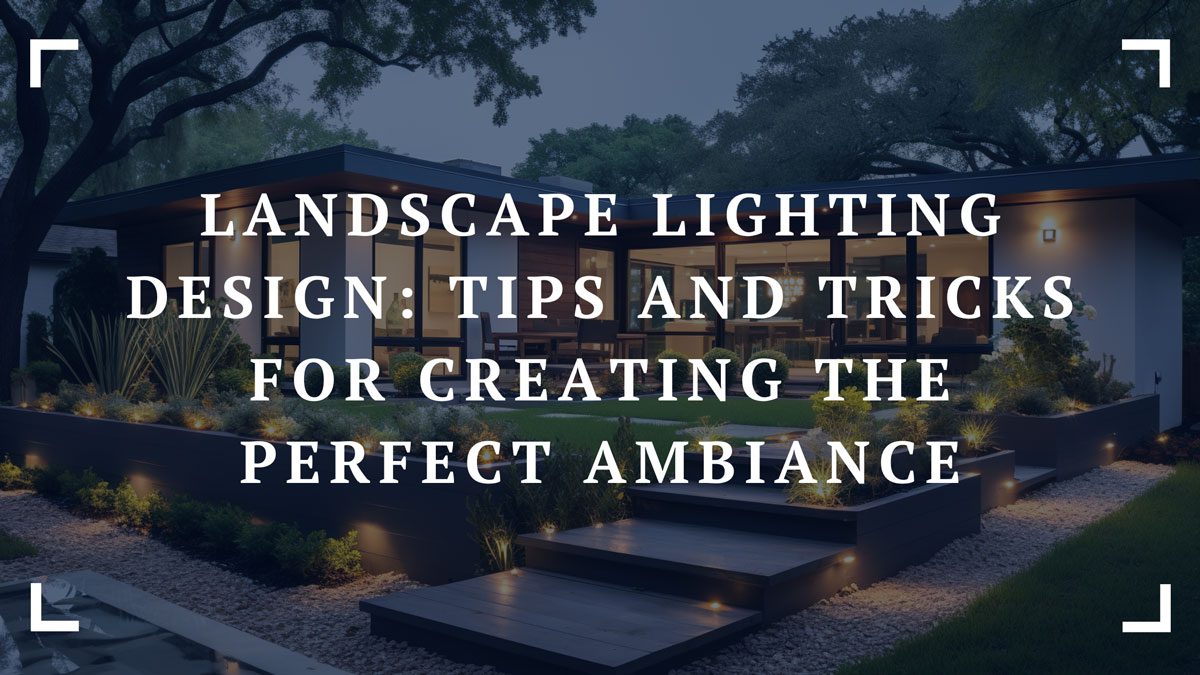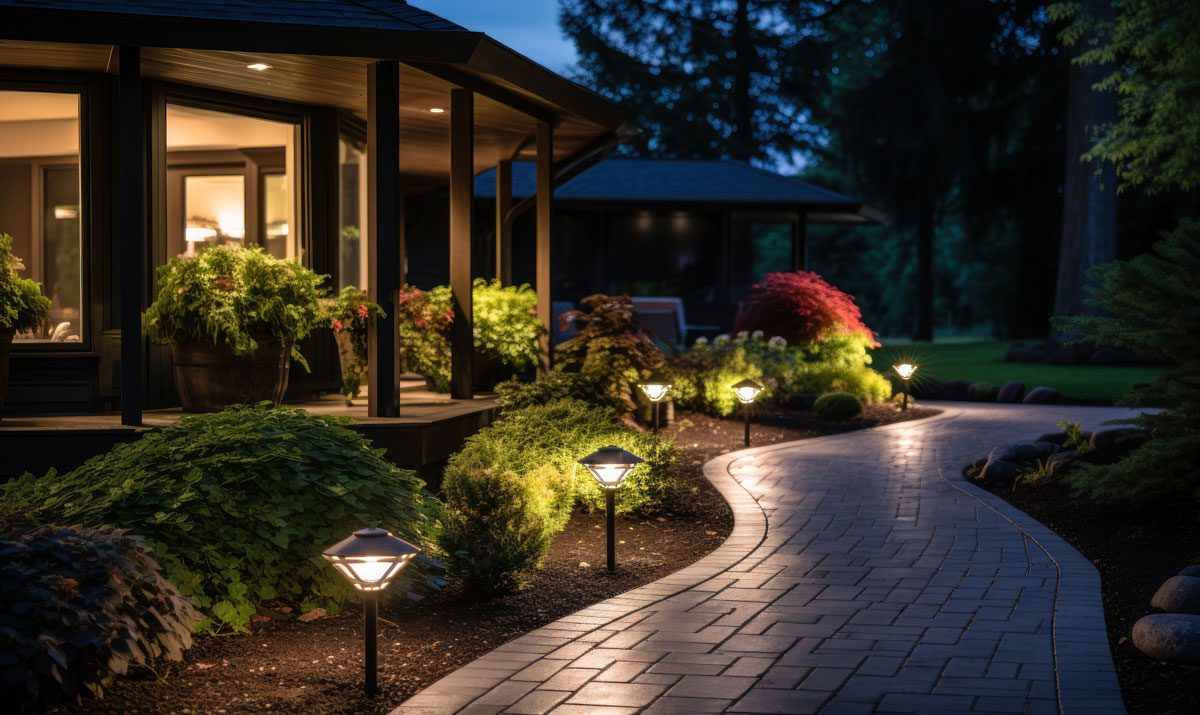Your outdoor living space is an extension of your home, and proper lighting design can transform it into an inviting oasis. Landscape lighting not only enhances the aesthetics of your property but also adds a sense of security and functionality. With the right lighting techniques, you can create the perfect ambiance, highlight your home’s architectural features, and showcase your garden’s beauty after dark.
In this comprehensive guide, we’ll explore various tips and tricks to help you design a stunning landscape lighting system that meets your needs and exceeds your expectations.

Understand The Purpose Of Landscape Lighting
Before going into the specifics of the design process, it’s beneficial to understand the various purposes of landscape lighting. This will help you determine the appropriate lighting techniques and fixtures for your specific goals.
- Safety and Security: Well-lit pathways, entryways, and stairs can prevent accidents and deter unwanted visitors, providing a sense of security for your family and guests.
- Functionality: Lighting can enhance the usability of your outdoor spaces, allowing you to extend your time spent outside and enjoy activities like dining, entertaining, or simply relaxing.
- Aesthetics: Strategically placed lighting can highlight your home’s architectural features, accentuate landscaping elements, and create a visually pleasing atmosphere.
With these purposes in mind, you can begin to plan your landscape lighting design effectively.
Assess Your Outdoor Space and Lighting Needs
Begin by evaluating your outdoor area and pinpointing necessary lighting spots like entrances, paths, and relaxation zones. Note existing lights and natural illumination from surroundings, determining if they can blend into your new plan.
Understand the function needed for each lighting area, whether it’s ensuring safety on walkways or enhancing the ambiance in leisure spaces.
With this initial assessment, you’re ready to develop a detailed lighting plan. For optimal results, consider hiring outdoor lighting professionals. They can craft a custom-designed system that suits your space’s unique needs, elevating its functionality and charm.
Choose The Right Lighting Fixtures and Bulbs
With a clear understanding of your lighting needs, it’s time to select the appropriate fixtures and bulbs. The market offers a wide range of options, each designed to serve specific purposes and create distinct effects.
- Path Lights: These low-profile fixtures are ideal for illuminating walkways, stairs, and driveways, providing a subtle yet functional glow.
- Uplights: Positioned at the base of trees, walls, or architectural features, uplights create dramatic effects by casting light upwards, accentuating textures and shapes.
- Downlights: Mounted on trees, pergolas, or overhangs, downlights cast a warm glow on seating areas, patios, or garden beds.
- Floodlights: Designed to illuminate large areas, floodlights are commonly used to highlight focal points like sculptures or landscaping elements.
By carefully considering each fixture’s role and the type of bulb that best suits your needs, you can achieve a harmonious and effective outdoor lighting set-up.
Explore Advanced Lighting Technologies and Innovations
As landscape lighting evolves, new technologies and innovations offer enhanced functionality and aesthetic appeal. Familiarizing yourself with these advancements can transform your outdoor spaces into state-of-the-art environments.
- Adopt Smart Lighting Systems: Look into the integration of smart lighting into your landscape. These systems allow for remote control, programmability, and customization through smartphone apps, enabling dynamic changes to your outdoor lighting with just a few taps.
- Utilize Energy-Efficient Solutions: Consider LED lights for their longevity and energy efficiency. Explore solar-powered options for an eco-friendly solution that reduces electricity use and harnesses natural resources.
- Incorporate Motion Sensors and Timers: Implement motion sensors for security and efficiency, lighting up areas as needed. Timers can automate your lighting set-up, ensuring lights are only on when necessary, saving energy and costs.
By integrating these advanced lighting technologies and innovations into your landscape, you can create a more efficient, customizable, and modern lighting environment.
Tailor Lighting For Diverse Settings
Designing landscape lighting requires a tailored approach to fit the unique characteristics of each environment. Whether your space is in a bustling city, a tranquil suburb, or expansive rural land, understanding the distinct needs and advantages of each setting is essential.
- Urban Settings: In urban landscapes, light pollution from surrounding buildings and streets can affect your design. Focus on enhancing privacy with directional lights, drawing attention to architectural features, and creating inviting outdoor spaces with soft, warm lighting to retreat from the city’s hustle.
- Suburban Gardens: These areas offer more room for creativity due to larger outdoor spaces. Employ layered lighting techniques for versatility, ensure pathways and entrances are well-lit for safety, and use uplighting to highlight trees, garden beds, and architectural details of your home.
- Rural Properties: The absence of ambient light in rural settings requires efficient visibility and security measures. Utilize high-intensity lights for pathways and entrances, solar-powered solutions for remote areas, and strategic lighting to accentuate natural features like ponds and rock formations.
By adapting your landscape lighting to fit these diverse environments, you can create welcoming and well-lit outdoor areas tailored to your home’s unique landscape.
Implement Lighting Techniques and Principles
Once you’ve selected your fixtures and bulbs, it’s time to implement various lighting techniques and principles to create the desired ambiance. Here are some effective approaches:
- Layering: Combine different types of lighting fixtures to create depth and dimension in your outdoor space. For example, use path lights for safety, uplights for drama, and downlights for ambiance.
- Highlighting: Draw attention to architectural features, landscaping elements, or focal points by strategically placing lights to highlight their unique characteristics.
- Shadowing: Utilize shadows to create depth and interest by casting light from different angles, creating unique patterns and textures on surfaces.
- Silhouetting: Position lights behind objects like trees or sculptures to create striking silhouettes, adding visual interest and depth to your outdoor space.
- Color Temperatures: Experiment with different color temperatures to set the desired mood. Warmer tones create a cozy, intimate atmosphere, while cooler tones provide a more modern and crisp feel.
By implementing these techniques and principles, you can create a cohesive and visually appealing lighting design that enhances the overall look and feel of your outdoor space.
Integrate Landscape Lighting With Other Outdoor Elements

For a truly cohesive outdoor living experience, consider integrating your landscape lighting design with other elements in your outdoor space. This can include:
- Water Features: Strategically placed lighting can highlight the movement and reflections of water features like fountains, ponds, or waterfalls. This creates a serene and peaceful atmosphere.
- Outdoor Kitchens and Dining Areas: Incorporate task lighting for food preparation and ambient lighting for dining and entertainment areas. This contributes to an inviting environment.
- Seating Areas and Fire Pits: Use a combination of path lights, uplights, and downlights to illuminate seating areas and fire pits, allowing you to enjoy your outdoor living space well into the evening hours.
By integrating your landscape lighting design with other outdoor elements, you can create a cohesive and immersive experience that enhances the overall functionality and enjoyment of your outdoor living space.
Adapt Landscape Lighting For Seasons and Events
Seasonal changes and special events provide unique opportunities to enhance your landscape lighting and create memorable atmospheres. Adjusting your outdoor lighting to align with different seasons and celebrations can transform your space, making it more suited to the occasion.
- Holidays: Utilize thematic colors and special fixtures to celebrate holidays throughout the year. For Christmas, integrate red and green lights with your existing set-up; for Halloween, add eerie orange and purple lighting to create a spooky atmosphere.
- Parties: Dynamic, colorful lighting can elevate any party atmosphere. Consider installing temporary, color-changing LED lights and incorporating decorative lanterns or string lights to create a festive, fun environment that complements the theme of your event.
- Seasonal Changes: Adapt your lighting to reflect the mood of each season. In summer, emphasize warm, soft lighting to invite outdoor evening gatherings; in winter, use brighter lights to compensate for the longer nights and add warmth to the cold season.
- Special Occasions: For anniversaries, birthdays, or romantic dinners, adjust your lighting to create a more intimate setting. Dimmer lights, combined with accent lighting on focal points like tables or garden features, can add a personal touch to your celebration.
Adjusting your landscape lighting for different seasons and events can significantly enhance the ambiance of your outdoor space. By incorporating these changes, you create a dynamic and adaptable environment that can evolve with your entertaining needs and aesthetic preferences.
Ensure Proper Installation And Maintenance
Proper installation and maintenance are crucial for the longevity and effectiveness of your landscape lighting system. Here are some important considerations:
- Wiring and Connections: Make sure that all wiring and connections are properly installed and protected from moisture and environmental factors. Consider using low-voltage systems for added safety and energy efficiency.
- Fixture Placement: Position your fixtures strategically to achieve the desired lighting effects while avoiding glare or light trespass onto neighboring properties.
- Timers and Controls: Incorporate timers, motion sensors, or smart lighting controls to automate your system, conserve energy, and enhance convenience.
Clean fixtures as needed to maintain optimal performance. Also, periodically inspect your lighting system for any issues, including:
- Burned-out bulbs
- Damaged fixtures
- Exposed wiring
By prioritizing proper installation and maintenance, you can ensure that your landscape lighting system operates efficiently and safely, providing years of enjoyment.
Final Thoughts
Designing the perfect landscape lighting system takes careful planning, attention to detail, and a deep understanding of lighting principles and techniques. By following the tips and tricks outlined in this guide, you can create a stunning outdoor ambiance that enhances the beauty of your property. More importantly, it provides safety, functionality, and a welcoming atmosphere for you and your guests to enjoy.


